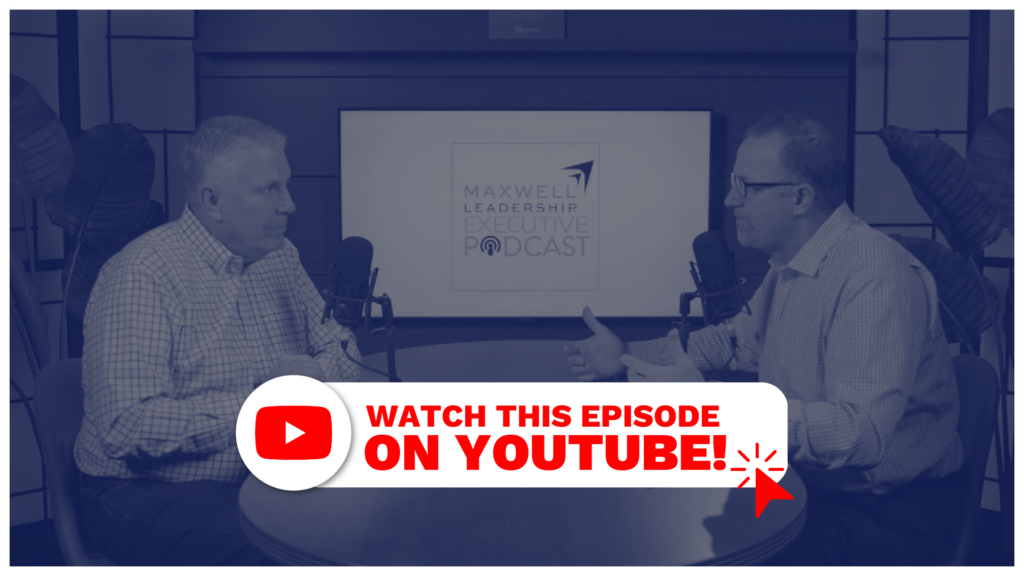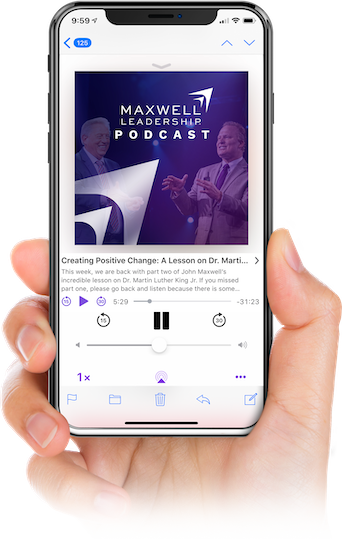Executive Podcast #242: Can Your People Challenge You?

Some leaders take great offense when someone on the team disagrees with the direction and decisions that the leader is making. Do you invite dissent?
Download our Learning Guide for this podcast!
Perry Holley:
Welcome to the Maxwell Leadership Executive Podcast, where our goal is to help you increase your reputation as a leader, increase your ability to influence others, and increase your ability to fully engage your team to deliver remarkable results. Hi, I’m Perry Holly, a Maxwell leadership facilitator and coach.
Chris Goede:
You and I’m Chris Goede, executive vice president with Maxwell leadership. Welcome and thank you for joining. If you’re interested in downloading the Learner guide that Perry created for us today with the lesson and the content, we’re going to talk about that. I would love for you to go to MaxwellLeadership.com/Podcast, and there you can leave a question or a comment, also access to a blog that goes along with some of the content that we’re providing for you today. Well, today’s topic is titled can your people Challenge You? I thought about this and I was like, sure they can. But do they? Right? Yeah. Can they challenge you?
Perry Holley:
That’s good.
Chris Goede:
But I like where you’re going with this, which is, are you allowing that right? Like, are you allowing your people to create tension, to refine each other, and to challenge you? To challenge them? Is that what you’re talking about here? Unpack this a little bit.
Perry Holley:
It comes up on coaching is that many leaders, they want to make the decision and they don’t want to hear from anybody. They just dictate it. I was on a call earlier today where a guy said he’s just so tired of having things forced down our throat, they never ask us what we think. And it comes up quite a bit is that do you invite dissent from your team? And they look at me like, I’ve got three heads and say, why would I do that? How would I do that? Why would you want to do that? And I just want the team thinking, I want them participating. What am I not seeing? What am I missing? It takes a little bit of personal security. An insecure leader can’t really do this because they don’t want to think that they need any help. But I think most of us would say, I need help. I need other smart people thinking about this. And so I wanted to review a couple of items today about if you’re not people aren’t dissenting, why and can you help them with that?
To be a Successful Leader, You Need Feedback on Your Leadership.
We’re excited to announce our new and improved Organizational Effectiveness Survey (OES). The OES gathers feedback from employees to give leaders and management the knowledge and action plans needed to develop a more effective and productive work environment. Our new version measures 4 areas of your business: Leadership, People, Strategy, and Performance.
Chris Goede:
Well, I’ve heard one of the content pieces you’ve recently created for us here at Maxwell Leadership is the Inclusive Leadership Training Course. By the way, if that’s something that would add value to your team, definitely visit Leadership.com Podcast and fill out th form. It is something that is being received extremely well, and it’s something that’s needed out there. Another content piece. Again, I’m not pushing all these content pieces, but you’re working on one right now in partnership with Tim Elmore around generational diversity. It made me think about both of those content pieces as we were talking about Chris, allowing people to challenge you as a leader. And I think everybody says we have diversity on the team, but we don’t really allow th diversity to live itself out. And as leaders, we often would hire somebody, man, we need somebody just like you with the way you’re thinking, and we want you to challenge the way we do things around here, and then we bring them in. And we don’t leverage that diversity. We don’t allow that different perspective to speak into what we’re doing and the decisions that we’re making as a leader. And so we say that we want that. But I think at the end of the day, we probably have some insecurities that don’t allow the team to speak freely and to share that diversity of thought, which then we’re stating the fact that we don’t want to be challenged as a leader in what we’re thinking, saying or doing.
Perry Holley:
Well, my statement is not mine. I probably heard from John 100 years ago that all of us are smarter than one of us. And if the success of our team is completely tied to my brain alone, we could be in trouble. So I really would want to involve the voices of many. And your point about diversity is incredibly important, is that if people don’t feel like you can hear from them, they will assimilate to be like you. So all that diversity that you put on your team, you just lost. Because now I’m just going to salute and stay mute and just do what you say. I’m not going to offer anything.
Chris Goede:
It reminds me of a story you tell about when you were a younger executive around the table, and the leader is like, Perry, if we think the same thing, then one of us is not needed here, and it’s not me. Okay, I got a thought.
Perry Holley:
I’ll bring a point of view for that. So anyway, I have six ideas.
Chris Goede:
What?
Perry Holley:
Here’s what I’m going to do next week. I promise I’ll do. Four. Yeah, we’ll average five. It’s over two week average of five. But some ideas, practical ways to say, am I inviting descend? And number one for me was lead by example. Can you demonstrate the value and respect of diverse opinions by actively seeking out ideas and viewpoints from others? So that idea like that leader said, Perry, what’s your point of view? And I had a cute answer. No. Do you require people to have a point of view?
Chris Goede:
Yeah. Allow for your teams to have open discussion and listen to what’s being said and maybe ask a question behind the question of what’s being talked about. Really dig into and consider alternative perspectives and be open to it. Allow people to have a differing thought and to challenge you and really sit in it, kind of, and learn and ask questions and unpack that. And I think if you do that, then what’s going to happen is they will we say all the time that leadership is contagious, then they’re going to see you modeling that behavior. And when you have to challenge them, hopefully that behavior will be the same as what you’re modeling. And so we need to make sure that we are doing that. It reminds me of we’ve talked about alignment versus agreement in team meetings. And one on one, you want people to speak their perspective, their thought of mind. You want them to up level ideas. Ultimately, you’re the leader and you get paid to make a final decision. But as a team, we want to make sure that everybody is speaking what they’re thinking and we leave in alignment. We may not be all in agreement, but that’s okay. And I think that’s a powerful tool around leading by example, especially. Let me add this. When the change or the decision comes from somebody else that changed your mind or challenged you, I think that’s key to be able to live that out. Well, this leads us to number two, which goes right what we were talking about. Is it safe to tell you what I think? Do your people feel safe? And you’re like, oh, there’s Perry and Chris. Four, six, 5250. I don’t know how much you weigh, but I weigh 250 plus talking about safe, match that. Yeah, okay. Yeah. I just didn’t want to throw you under the bus.
Perry Holley:
We’re a force, let’s just put it that way.
Chris Goede:
Yeah, that’s right. But what we’re talking about here is th psychological safety of allowing people to share what they think to challenge a certain situation. And so we have to, as leaders, create an atmosphere of trust where they feel comfortable being able to do that. And I think if they are assured that they have your trust and that they can do that and that they’ll be heard, then I think they’ll take in that into consideration and be more than willing to share what they’re thinking.
Perry Holley:
I think this is one of the biggest points of this conversation, is that if you think you have the best intentions in the world, but if people don’t trust your motive, if they don’t trust your candidness, if they don’t trust that you can handle what I have to say, they are going to hold back. They’re not going to feel safe, and you’re not in this consistency of your emotions is that you can say hard things to me and I don’t blow up. I receive that from you. I listen for that. One thing I learned from Tim Elmore in this work on the generational diversity was I asked Tim, I want to exude confidence, but have some humility about it. I want to hear from you. I want you to know I’m open to hearing that. And Tim says this is a great quote. He said, I talk like I’m right and I listen like I’m wrong. I just love that I can talk with confidence and be bold, but I also want you to talk with confidence and be bold. So when I finish talking, I think I’m right, but I’m going to listen like I’m wrong, which brings in a dose of humility and teachableness to me that invites people to say, man, my boss is kind of teachable. I think I’ll share with that leaders.
Maxwell Leadership Growth Plan Ad:
You know better than anyone that growth is essential if you want to make tomorrow better than today. But fitting growth into your calendar takes intentionality and self discipline. So let Maxwell Leadership help make your growth achievable. You’re invited to join thousands of worldwide leaders in using the Maxwell Leadership Growth Plan. The Maxwell Leadership Growth Plan provides you with convenient and easy to implement leadership resources, including video lessons from John Maxwell, all at your fingertips, available in our Maxwell Leadership app or online, you’ll be coached by many well known leadership experts that will help you achieve your growth goals. You can even listen to this podcast right there in the app. Check it out for free today at Growth.MaxwellLeadership.com. That’s Growth.MaxwellLeadership.com.
Perry Holley:
Number three was, could you increase the opportunities to dissent? Well, why would I want to do that? Well, the idea here is that we tend to think about how do we give people a chance to voice their opinions? And this could include regular team meetings, of course, is what we’re normally thinking. But what about one on ones that you have about anonymous suggestion boxes or online platforms where you can plant ideas or leave ideas? It could be anonymous. I really like the idea of building trust one on one and then bring it to the group. And leading by example, as we said, number one, that I’m going to have a point of view. I insist you share your point of view. Matter of fact, I may insist you share your point of view first, so it doesn’t sound a lot like my point of view. Really get people talking to me in an honest, candid way.
Chris Goede:
I love that. And I love that we’re talking about this in open meetings. There’s a right way to go about doing it and to open that up and say, hey man, let’s push back on this, like, challenge this. I’ll give you an example because I think you can do it in both open meetings, but then also some you may have to follow back up on a one on one conversation because that’s just not how they’re wired. They may not be comfortable doing that in a group setting, but they would be comfortable doing in a one on one setting. Just recently this week, I had a meeting and I was encouraging some tension in a certain decision that we were looking to make and encouraging pushback on what I put out there in the ecosystem for them to challenge. And I noticed one individual that we were on a zoom call, and I noticed that the body language did not look very engaged and wasn’t very talkative. And so I was like, I want to have a conversation one on one. So I had a conversation later that day, one on one, and I said, hey, talk to me a little bit about what are your thoughts around Chris? And there’s just brilliant stuff coming out. And so I was able you mentioned in here about using those one on ones as a coaching moment for those that are not comfortable. Some are very comfortable, by the way. We have several on our team that feel that way, but when they’re not, it allows you to kind of coach them in a private one on one setting and speak into the fact that you believe that what they think and their perspective and their point of view, and that’s why they’re on the team. It was interesting conversation that hopefully encourages that individual that the next time that comes up, if they’re feeling something or that they want to share, they want to push back, that they will do that. But the only way they were able to do that was because I was aware of a body language and what was going on in the meeting and then had that one on one conversation.
Perry Holley:
I can just add before you go to number four, you just triggered something that we have been trying in my last role, that there are people in the team that you and I are pretty open, pretty out there, pretty public. We don’t have trouble sharing. There are others that are more quiet, more private, more protective of their thoughts, and they’re more introverted versus our extroversion. One thing you can do to help the quiet of the introverted is to give them if you’re going to have a discussion of something, seat it with them in advance. Let them know here’s what we’re going to be talking about in the meeting. Could you put some thought in this before coming to the meeting? You and I throw a subject we could talk about. It way long right now, but a lot of people don’t have that.
Chris Goede:
That’s good.
Perry Holley:
So can you help them with that?
Chris Goede:
That’s good. I love that. Well, number four of six. Number four is ask thought provoking questions. Instead of just seeking agreement, pose a question out to the team and challenge the status quo. Let them hit it around a little bit in the room and encourage everybody to participate. This reminds me of a little exercise we do in some of our facilitating training where this or that? I challenge leaders all the time to say, hey, what’s a change you’re going to make, what’s a new direction you want to go? Whatever it is, create a couple of questions around that with different scenarios, and then put them out to the team and make them pick a side and then defend it and have a conversation. And so there’s a way that you can say, hey, do you think we should do this or do you think we should do that? Have at it and then go, okay, here’s another question for you. So really by being able to ask those questions, it’ll lead to them being able to feel more comfortable speaking their mind about a certain situation.
Perry Holley:
Often overlooked leader skill here is the skill of curiosity that are you genuinely curious about what other people think? Are you really curious about do you want to encourage this innovation and creativity in others? Are you curious about how they would solve the issue that you’re facing? And I know that we can ask good questions. I’ve often heard asking a question is getting you to prove you already know something. But curious is me trying to learn something. And I love that little reminder is that when I’m going to ask questions, am I really trying to learn something new? I’m curious, how would you solve this with you or me? What would you consider? What are the biggest challenge? What’s the biggest risk? And I’m curious where you feel like we’re going here and get them engaged that way.
Chris Goede:
Good.
Perry Holley:
Number five of six is encourage respectful. Debate is establish ground rules if you need to, to have healthy disagreement. Active listening needs to be a part of it that you avoid personal attacks. You focusing on issues other than focusing on the issues other than the individual saying the issues. I don’t know if you’ve seen this, but allowing and encouraging, go ahead and let’s argue, but we’re going to do it respectfully.
Chris Goede:
Yeah. Trust is the currency to all leadership. And I think that if you have trust, then you can have these open debates, even if they get a little bit heated. You want passionate people standing up for what they believe and want to challenge certain things in your leadership in a respectful way. We’re not talking about not being respectful, but if there’s trust there, it shouldn’t be a problem. And to make sure there’s just pure motive, Perry’s mentioned that word a couple of times today about the motive behind the debate. It reminds me of that saying of, hey, let’s make sure as leaders that we want to do right more than we want to be right. And I think that if we get into the mode of we just want to be right, then you’re not open to people challenging or having a debate. But if you want to do what’s right for the people, for your team, for the organization, then you’ll be open to that. Well, the last one, number six, host and we talked about this a couple of weeks ago on our podcast, an after action review. And we want to make sure that you reflect on kind of the decisions that may have changed when you were challenged. And then share I love this too, is I want to share and encourage team members to say, hey, you know what I was thinking down this way. And then when I look at kind of reviewing what we did, you said something that challenged my thinking, and then we ended up doing it this way, and I think it worked a whole lot better. Hey, thanks for being willing to do that. And so I think if you can just encourage people by talking about the lessons learned, the feedback, and how challenging those situations impacted that decision, I think you’ll continue to get it in the right way.
Perry Holley:
I do too. And the bottom line is, I really want my team thinking like owners, not like hired hands. I need them to what would they do if they were me? I need to know that they can contribute. I need to leverage their diversity of thought, diversity of backgrounds, diversity of come from that they see things different than me. If we’re all like me, like you said, one of us isn’t necessary. So I really want to leverage that diversity. I don’t want them to assimilate to be like me. I want to leverage the diversity. I spent a long time building on this team so that we get the best outcome possible.
Chris Goede:
Yeah. Well, as I wrap up, can people challenge you 100%? Are you going to allow them to challenge you? Man, I hope so, because I think Rising Tide raises all boats, and that’s what we’re here for. We’re here to challenge each other, to sharpen each other. And to be able to do that, it takes security as a leader. But remember, if the motive is pure, you’ll be open to that, and you got to lead by example. You have to be willing to be challenged before I think you can challenge other people. And so just keep that in mind and hopefully dive into the six items that we talked about. If you didn’t ahead of time, I would encourage you to download the Learner’s guide so that you can kind of make some notes. Maybe you were driving, maybe you’re out exercising. But sit down and really look at each one of these and say, how can I do a better job of this so that I’m more transparent with my team?
Perry Holley:
Fantastic. If you’d like to get that Learner guide, leave a question or a comment. You can do all that at MaxwellLeadership.com/podcast. You can also learn about our offerings there, and we love hearing from you. So please go there and leave us a comment or a question, and we’re very grateful you’d spend this time with us today. That’s all today from the Maxwell Leadership executive podcast.













Be the first to comment on "Executive Podcast #242: Can Your People Challenge You?"